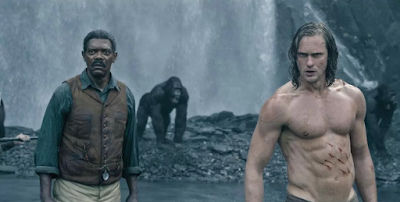Sections of this film are so imaginative, and so lovely, that they deserve our open-heartedness, not our scorn
Conceptually, at least, David Yates’ The Legend of Tarzan, starring Alexander Skarsgård as the fantastically brawny lord of the jungle, just can’t win. It’s adapted from a series of boys’ adventure books written in the early 1900s, when racial and social awareness wasn’t anything close to what it is today, and “colonialism” wasn’t yet a word that was always preceded by “the evils of.” The world is better off, now that we’ve learned—or at least are learning—to think and talk about these things. But what about Tarzan, Edgar Rice Burroughs’ English and very white lord raised in the African jungle by apes, a man in tune with his body and with nature, but one who must also, eventually, adjust to the mores of civilization? The ape-man has lived for a very long time through Burroughs’ books, and through almost countless movie and TV adaptations, including the Johnny Weissmuller and Maureen O’Sullivan films of the 1930s and early ‘40s—which were, it should be noted, insensitive to issues of race.
So what are we supposed to do with Tarzan, now that we know better? It would be easier, maybe, to retire him forever than to try to replace his loincloth of casual unselfconsciousness with a specially designed supergarment of awareness and sophisticated thinking.
But it’s impossible for art to move things forward if we simply think of the past as a place where everyone got everything wrong. With The Legend of Tarzan, Yates—who directed four of the Harry Potter movies, infusing all of them with the proper velvety, moody magic—gives us the best possible Tarzan for our time, one who seems to know intuitively what a complicated minefield he’s stepping onto. That doesn’t diminish the pleasures of the movie—it simply makes us feel better about savoring them. And sections of The Legend of Tarzan are so imaginative, and so lovely, that they deserve our open-heartedness, not our scorn.
Conceptually, at least, David Yates’ The Legend of Tarzan, starring Alexander Skarsgård as the fantastically brawny lord of the jungle, just can’t win. It’s adapted from a series of boys’ adventure books written in the early 1900s, when racial and social awareness wasn’t anything close to what it is today, and “colonialism” wasn’t yet a word that was always preceded by “the evils of.” The world is better off, now that we’ve learned—or at least are learning—to think and talk about these things. But what about Tarzan, Edgar Rice Burroughs’ English and very white lord raised in the African jungle by apes, a man in tune with his body and with nature, but one who must also, eventually, adjust to the mores of civilization? The ape-man has lived for a very long time through Burroughs’ books, and through almost countless movie and TV adaptations, including the Johnny Weissmuller and Maureen O’Sullivan films of the 1930s and early ‘40s—which were, it should be noted, insensitive to issues of race.
So what are we supposed to do with Tarzan, now that we know better? It would be easier, maybe, to retire him forever than to try to replace his loincloth of casual unselfconsciousness with a specially designed supergarment of awareness and sophisticated thinking.
But it’s impossible for art to move things forward if we simply think of the past as a place where everyone got everything wrong. With The Legend of Tarzan, Yates—who directed four of the Harry Potter movies, infusing all of them with the proper velvety, moody magic—gives us the best possible Tarzan for our time, one who seems to know intuitively what a complicated minefield he’s stepping onto. That doesn’t diminish the pleasures of the movie—it simply makes us feel better about savoring them. And sections of The Legend of Tarzan are so imaginative, and so lovely, that they deserve our open-heartedness, not our scorn.

Comments
Post a Comment